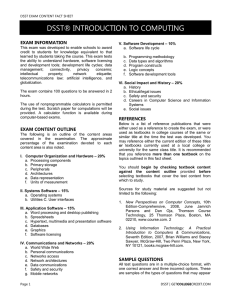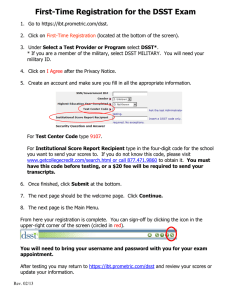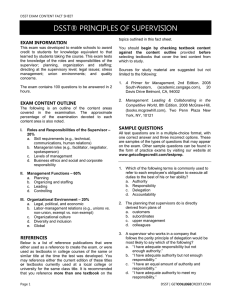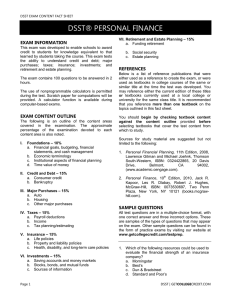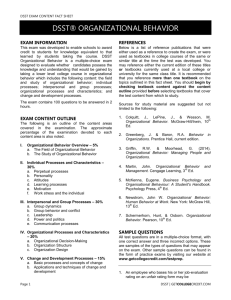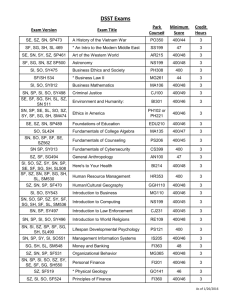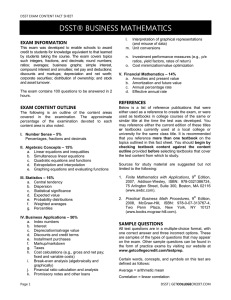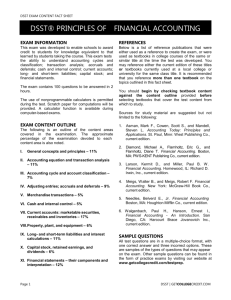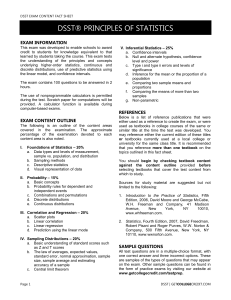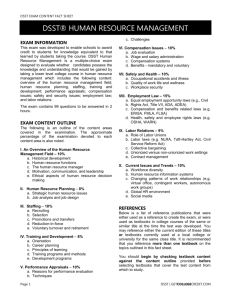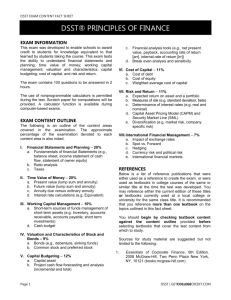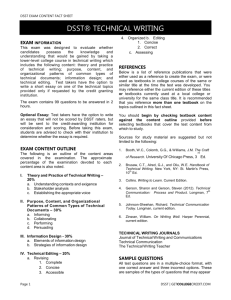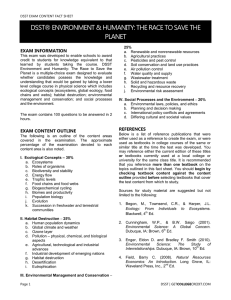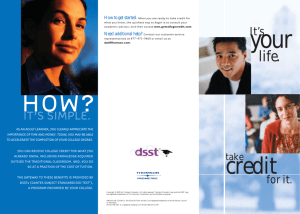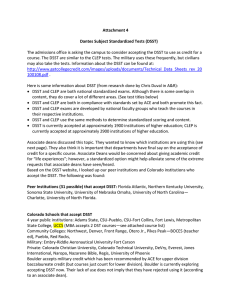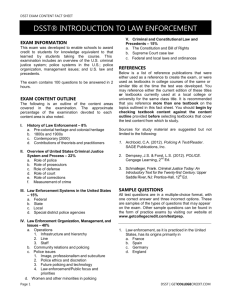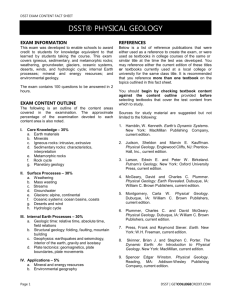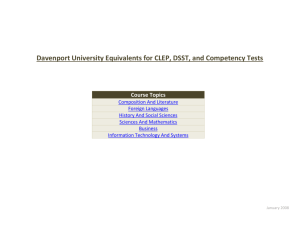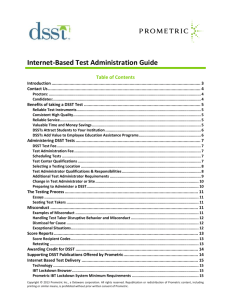DSST® PRINCIPLES OF PUBLIC SPEAKING
advertisement
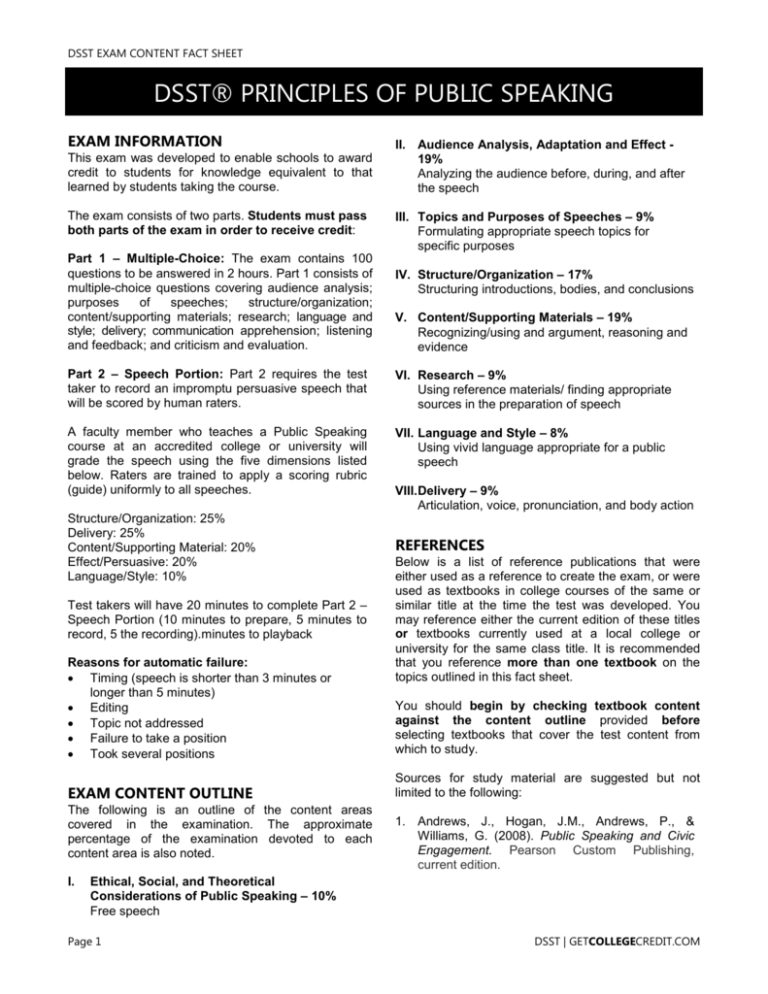
DSST EXAM CONTENT FACT SHEET DSST® PRINCIPLES OF PUBLIC SPEAKING EXAM INFORMATION This exam was developed to enable schools to award credit to students for knowledge equivalent to that learned by students taking the course. The exam consists of two parts. Students must pass both parts of the exam in order to receive credit: II. Audience Analysis, Adaptation and Effect 19% Analyzing the audience before, during, and after the speech III. Topics and Purposes of Speeches – 9% Formulating appropriate speech topics for specific purposes Part 1 – Multiple-Choice: The exam contains 100 questions to be answered in 2 hours. Part 1 consists of multiple-choice questions covering audience analysis; purposes of speeches; structure/organization; content/supporting materials; research; language and style; delivery; communication apprehension; listening and feedback; and criticism and evaluation. V. Content/Supporting Materials – 19% Recognizing/using and argument, reasoning and evidence Part 2 – Speech Portion: Part 2 requires the test taker to record an impromptu persuasive speech that will be scored by human raters. VI. Research – 9% Using reference materials/ finding appropriate sources in the preparation of speech A faculty member who teaches a Public Speaking course at an accredited college or university will grade the speech using the five dimensions listed below. Raters are trained to apply a scoring rubric (guide) uniformly to all speeches. VII. Language and Style – 8% Using vivid language appropriate for a public speech Structure/Organization: 25% Delivery: 25% Content/Supporting Material: 20% Effect/Persuasive: 20% Language/Style: 10% Test takers will have 20 minutes to complete Part 2 – Speech Portion (10 minutes to prepare, 5 minutes to record, 5 the recording).minutes to playback IV. Structure/Organization – 17% Structuring introductions, bodies, and conclusions VIII. Delivery – 9% Articulation, voice, pronunciation, and body action REFERENCES Below is a list of reference publications that were either used as a reference to create the exam, or were used as textbooks in college courses of the same or similar title at the time the test was developed. You may reference either the current edition of these titles or textbooks currently used at a local college or university for the same class title. It is recommended that you reference more than one textbook on the topics outlined in this fact sheet. Reasons for automatic failure: • Timing (speech is shorter than 3 minutes or longer than 5 minutes) • Editing • Topic not addressed • Failure to take a position • Took several positions You should begin by checking textbook content against the content outline provided before selecting textbooks that cover the test content from which to study. EXAM CONTENT OUTLINE Sources for study material are suggested but not limited to the following: The following is an outline of the content areas covered in the examination. The approximate percentage of the examination devoted to each content area is also noted. I. 1. Andrews, J., Hogan, J.M., Andrews, P., & Williams, G. (2008). Public Speaking and Civic Engagement. Pearson Custom Publishing, current edition. Ethical, Social, and Theoretical Considerations of Public Speaking – 10% Free speech Page 1 DSST | GETCOLLEGECREDIT.COM DSST EXAM CONTENT FACT SHEET – PRINCIPLES OF PUBLIC SPEAKING 2. DeVito, Joseph A. (2011). The Essential Elements of Public Speaking. New York, NY: Longman, current edition. 3. Griffin, Cindy L. (2005). Invitation to Public Speaking. Cengage Learning, current edition. 4. Hamilton, Cheryl (2011). Essentials of Public Speaking. Cengage Learning, current edition. 5. Jaffe, Clella (2013). Public Speaking. Wadsworth Publishing, 5th Ed. 6. O’Hair, Dan, & Wiemann, Mary (2011). Real Communication: An Introduction. Bedford/St. nd Martin's, 2 Ed. 7. Osborn, Suzanne, Osborn, Michael, & Osborn, Randall (2013), Public Speaking Guidebook. Allyn & Bacon, current edition. 8. Verderber, R.F., Sellnow, D.D., & Verderber, K.S. (2012). The Challenge of Effective Speaking. Belmont, CA: Wadsworth, current edition. SAMPLE QUESTIONS All test questions are in a multiple-choice format, with one correct answer and three incorrect options. These are samples of the types of questions that may appear on the exam. Other sample questions can be found in the form of practice exams by visiting our website at www.getcollegecredit.com/testprep. 1. In both classical and contemporary views of public speaking, primary attention is given to which of the following? a. Style of the speech b. Substance or content of the speech c. Delivery of the speech d. Organization of the speech 2. A speech divided into the three main divisions of animal, vegetable, and mineral would be best organized according to which of the following patterns? a. Temporal b. Cause-effect c. Topical d. Problem-solution 3. Speaker credibility refers most closely to which of the following? a. Persuasiveness b. Effectiveness c. Emotional appeal d. Believability Page 2 4. In his famous "Liberty or Death" speech, Patrick Henry said: “For my own part, I consider it as nothing less than a question of freedom or slavery; and in proportion to the magnitude of the subject ought to be the freedom of the debate. It is only in this way that we can hope to arrive at truth, and fulfill the great responsibility, which we hold to God and our country. Should I keep back my opinions at such a time, through fear of giving offense, I should consider myself as guilty of treason towards my country and of an act of disloyalty toward the Majesty of Heaven, which I revere above all earthly kings.” This excerpt provides an example of Henry's attempt to do which of the following? a. Establish the truth of his proposition b. Establish his credibility c. Present his opponents' arguments in a bad light d. Provide the audience with arguments to use against the alternative views they would hear from other speakers 5. The assumption that a person who is competent in one field is also competent in another field is referred to as which of the following? a. Halo effect b. Matching hypothesis c. Social exchange hypothesis d. Self-fulfilling prophecy 6. The predisposition to act for or against a person or position is referred to as which of the following? a. b. c. d. Attitude Belief Value Opinion 7. Most speeches should be prepared for which of the following audiences? a. Hypothetical b. General c. Specific d. Idealized 8. Which of the following terms is used for the argument that what a person hears last is remembered best and has the greatest effect? a. Primacy b. Recency c. Climax d. Anticlimax DSST | GETCOLLEGECREDIT.COM DSST EXAM CONTENT FACT SHEET – PRINCIPLES OF PUBLIC SPEAKING 9. The degree to which the audience members have counterarguments ready to answer an attack on their beliefs, attitudes, and values is referred to as which of the following? a. Persuasive presumption b. Inoculation c. Selective exposure d. Reinforcement 10. Which of the following patterns of organization would be most suitable for speeches such as "The events leading to World War II," "the development of language in the child," and "the major steps in learning to use a computer"? a. Spatial b. Chronological c. Problem-solution d. Cause-effect SAMPLE SPEECH TOPIC (PART 2) Topic: Some people believe that all states should be allowed to pass laws requiring the death penalty for certain crimes. Others feel that the death penalty is wrong and should be abolished. Try to persuade the audience of your position or point of view on the death penalty. Include supporting arguments to defend your position. Be sure to take the designated audience into consideration. CREDIT RECOMMENDATIONS The American Council on Education’s College Credit Recommendation Service (ACE CREDIT) has evaluated the DSST test development process and content of this exam. It has made the following recommendations: Area or Course Equivalent Level Principles of Public Speaking Amount of Credit Minimum Score Three (3) semester hours Source American Council on Education – College Credit Recommendation Service Lower-level baccalaureate 400 Answers to sample questions: 1-B; 2-C; 3-D; 4-B; 5-A; 6A; 7-C; 8-B, 9-B, 10-B. Audience: A college public speaking class composed of female and male students ranging in age from 18 to 30 Page 3 DSST | GETCOLLEGECREDIT.COM DSST EXAM CONTENT FACT SHEET – PRINCIPLES OF PUBLIC SPEAKING Rev 2/2014 Page 4 DSST | GETCOLLEGECREDIT.COM
